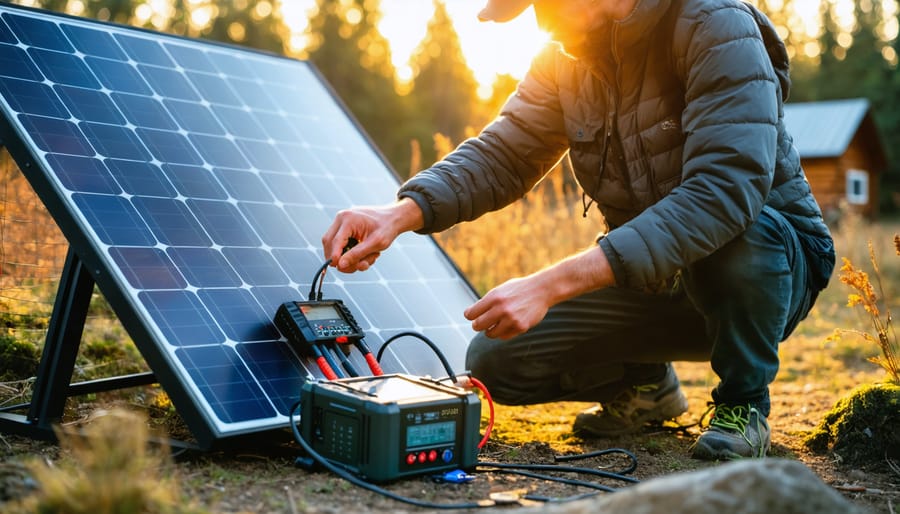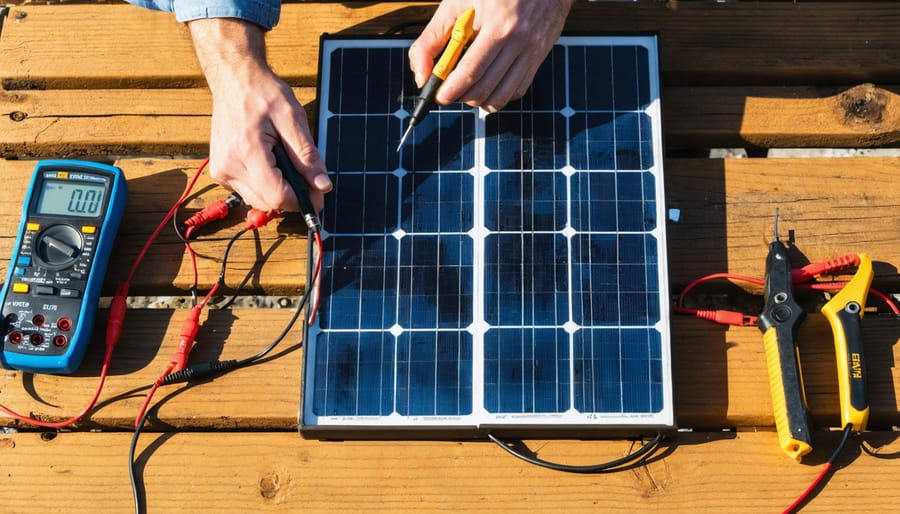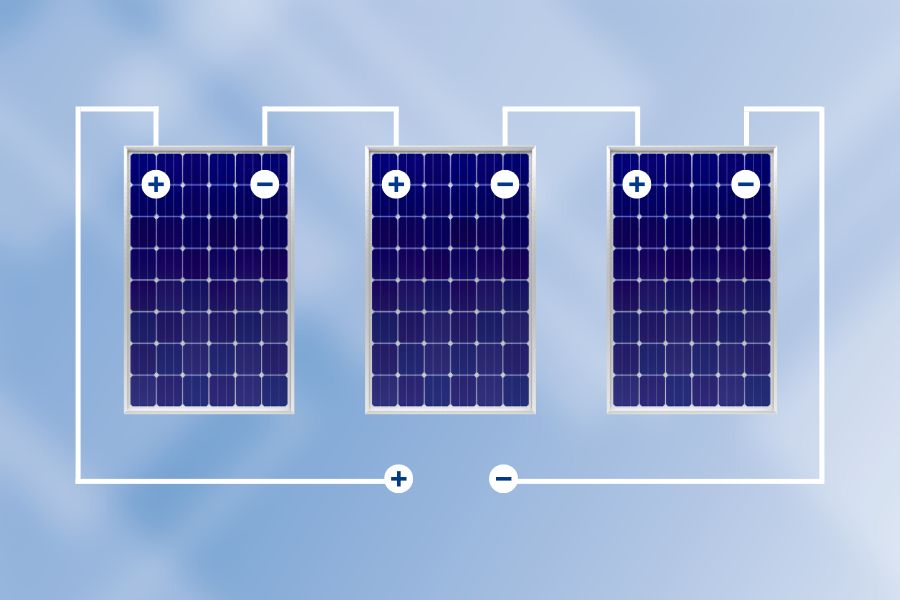Stop Guessing Energy Numbers: Your Practical Joule Conversion Reference
Updated:

**Understanding Energy in Real Numbers: Your Joule Conversion Guide**
Converting joules into watts, kilowatt-hours, or calories transforms abstract energy measurements into practical numbers you can actually use for your solar projects and off-grid calculations. Whether you’re sizing a battery bank, calculating how long your portable solar panel will run a laptop, or determining if your DIY solar setup generates enough power for camping trips, mastering these conversions eliminates guesswork and prevents costly mistakes.
I learned this the hard way during my first solar installation. I miscalculated joules to watt-hours and ended up with a battery system that couldn’t power my workshop through the evening. That frustrating experience taught me that understanding energy conversions isn’t just academic—it’s the difference between a system that works and one that disappoints.
A joule represents one watt of power sustained for one second, but that definition doesn’t help when you’re standing in front of a solar charge controller trying to figure out daily energy production. You need quick conversions: joules to kilowatt-hours for utility comparisons, joules to calories for thermal applications, or joules to BTUs when discussing heating efficiency.
This guide provides a comprehensive conversion chart alongside real-world examples from solar DIY scenarios. You’ll find the exact multipliers needed for common conversions, understand when precision matters versus acceptable approximations, and discover calculator tools that eliminate manual math. Whether you’re a complete beginner or experienced DIYer expanding your renewable energy knowledge, these conversions become second nature with the right reference at hand.
What Exactly Is a Joule (And Why Should You Care)?
Think of a joule as energy’s most basic measuring stick—it’s the universal unit scientists use to measure how much work something can do. But let me break that down into something more useful for your solar projects.
When I first started tinkering with solar panels, I’ll admit I was completely confused by joules. Then someone gave me this analogy: one joule is roughly the energy it takes to lift a small apple about one meter off the ground. Not much, right? That’s why you’ll rarely see joules by themselves in solar work—you’ll typically encounter *thousands* or even *millions* of them.
Here’s where it gets practical: when you’re checking battery storage capacity, it’s usually listed in watt-hours (Wh) or kilowatt-hours (kWh). But manufacturers sometimes list energy in megajoules (MJ), especially for camping equipment and portable power stations. Your solar panel’s output? Also measured in watts, which are actually joules per second. So a 100-watt panel produces 100 joules of energy every single second it’s running at full capacity.
You’ll encounter joules most often when you’re:
– Comparing battery capacities across different brands that use different units
– Calculating how long your portable solar setup can run specific devices
– Reading technical specifications on imported equipment that uses metric measurements
– Figuring out heating requirements for solar thermal projects
Understanding joules helps you speak the same language as your equipment specs. Once you know how to convert between joules, watt-hours, and kilowatt-hours, you can accurately compare any energy storage device or calculate whether your solar setup can actually power what you need it to power—no guesswork required.

The Essential Joule Conversion Chart
Joules to Watt-Hours (The Solar Standard)
When I first started comparing solar panels and batteries, I was confused why everything listed watt-hours instead of joules. Here’s the thing: they’re both energy measurements, but the solar industry chose watt-hours because it’s more practical for everyday use.
The conversion is straightforward: **1 watt-hour equals 3,600 joules**. To convert joules to watt-hours, simply divide by 3,600. For example, if your portable battery stores 180,000 joules, that’s 50 watt-hours (180,000 ÷ 3,600 = 50 Wh).
Why does solar equipment use watt-hours? Because most devices are rated in watts, making the watts to watt-hours conversion intuitive. If you have a 100-watt solar panel generating power for 5 hours, you’ve produced 500 watt-hours—simple multiplication. Using joules would mean dealing with massive numbers like 1,800,000 joules, which isn’t user-friendly.
**Quick Solar Example:** Your phone battery holds 18,000 joules (5 Wh). A small 20-watt solar panel producing power for 30 minutes generates 36,000 joules (10 Wh)—enough to fully charge your phone twice. Understanding this conversion helps you accurately size your solar setup for real-world needs.
Joules to Kilowatt-Hours (Your Power Bill Unit)
Understanding your power bill becomes much easier when you can convert joules to kilowatt-hours (kWh). Since your utility company charges you in kWh, this conversion is crucial for calculating actual energy costs.
Here’s the simple conversion: **1 kWh = 3,600,000 joules (or 3.6 megajoules)**. To convert joules to kWh, divide by 3,600,000.
Let me share a real-world example from my own solar setup. Last summer, I calculated potential savings by measuring my array’s daily output. My panels generated about 21.6 million joules in one sunny day. Converting that: 21,600,000 ÷ 3,600,000 = 6 kWh. At my local rate of $0.13 per kWh, that’s $0.78 saved daily, or roughly $23 monthly!
You can make these calculations easier using our watts to kWh calculator, which handles the heavy lifting for you.
For quick reference: if your solar battery stores 5,000 watt-hours (5 kWh), that’s 18 million joules of stored energy—enough to run a laptop for days or keep essential appliances powered during outages. Understanding this conversion helps you make informed decisions about battery capacity and realistic expectations for your solar investment.
Joules to Calories and BTUs (For Heating and Cooking)
When I first started experimenting with solar water heating, I was puzzled by the mix of energy units on different products—joules on my solar collector specs, BTUs on my water heater, and calories in some old camping guides. Understanding these conversions made all the difference in sizing my system correctly.
Here’s what you need to know for practical applications:
**Joules to Calories:**
– 1 joule = 0.239 calories (small calorie)
– 1 joule = 0.000239 kilocalories (dietary Calories)
For heating water, remember that it takes approximately 4,184 joules (or 1 kilocalorie) to raise 1 liter of water by 1°C.
**Joules to BTUs:**
– 1 joule = 0.000948 BTU
– 1,000 joules (1 kilojoule) = 0.948 BTU
– 1 million joules (1 megajoule) = 948 BTU
These conversions are essential when comparing solar collector output (often in joules or kilojoules) to your heating needs. For example, if your camping stove produces 10,000 BTU/hour, that’s roughly 10.5 megajoules per hour—helpful for comparing it to portable solar cookers rated in watts or joules. When planning off-grid cooking or water heating, these conversions help you match your energy source to your actual needs.
Quick Reference Table
Here’s your go-to conversion table for those everyday solar and camping projects. I keep this printed and laminated in my workshop—saves me from pulling out my phone with greasy hands every time I need a quick conversion!
**Essential Joule Conversions**
| From | To | Multiply By |
|——|—–|————-|
| 1 Joule | Watt-hours (Wh) | 0.000278 |
| 1 Joule | Kilowatt-hours (kWh) | 0.00000028 |
| 1 Joule | Calories | 0.239 |
| 1 Watt-hour | Joules | 3,600 |
| 1 Kilowatt-hour | Joules | 3,600,000 |
| 1 Calorie | Joules | 4.184 |
**Quick Examples for Real Projects:**
– **100Wh portable battery** = 360,000 joules
– **1kWh solar panel output** = 3.6 million joules
– **12V 100Ah battery** = 1,200Wh = 4.32 million joules
Pro tip: For most DIY solar calculations, you’ll primarily convert between joules and watt-hours. Watt-hours are more intuitive when sizing batteries and solar panels—that’s why battery banks always list capacity in Ah (amp-hours) or Wh rather than joules. Just remember: multiply joules by 0.000278 to get watt-hours, or go the other direction by multiplying watt-hours by 3,600.
Real-World Energy Conversion Calculations
Calculating Solar Panel Output in Different Units
Solar panels generate energy constantly throughout the day, but understanding that output in practical terms means converting joules into more useful measurements. Here’s how to make sense of those numbers for real-world applications.
Since power is measured in watts (joules per second), a solar panel rated at 100 watts produces 100 joules every single second. To calculate your panel’s total energy output over time, you’ll multiply the wattage by the hours of operation. This gives you watt-hours (Wh), which is far more practical for sizing batteries and planning your system.
Let me share an example from Charles’s garage installation last spring. His 300-watt panel received about 5 hours of good sunlight daily. Here’s the calculation:
**Energy in watt-hours = 300W × 5 hours = 1,500 Wh (or 1.5 kWh)**
To verify this in joules: 1,500 Wh × 3,600 seconds/hour = 5,400,000 joules (5.4 megajoules).
While those joule numbers look impressive, they’re impractical for everyday use. Instead, focus on watt-hours when calculating solar panel charge time or determining how many panels you need.
**Quick conversion formula:**
– Joules ÷ 3,600 = Watt-hours
– Watt-hours ÷ 1,000 = Kilowatt-hours (kWh)
Charles discovered that thinking in watt-hours made system planning much simpler—he could easily compare his panel output against his battery capacity (measured in amp-hours, which converts directly to watt-hours). This practical approach helped him avoid overcomplicating what should be straightforward calculations for his weekend projects.

Battery Storage Capacity Conversions
When you’re building a battery bank for your van, RV, or off-grid solar setup, understanding energy conversions becomes crucial for getting the right size batteries. Let me share what I’ve learned through trial and error—trust me, understanding these conversions saved me from undersizing my first camper van battery!
Battery capacity is typically measured in amp-hours (Ah), but your solar panels produce watt-hours (Wh), and technically all that energy is measured in joules. Here’s how they connect: 1 watt-hour equals 3,600 joules. For amp-hours, you need to factor in voltage—multiply amp-hours by voltage to get watt-hours, then convert to joules if needed.
Let’s say you’re planning a weekend camping trip and need to power a 12V refrigerator that uses 50 watts for 10 hours daily. That’s 500 watt-hours, or 1,800,000 joules of energy. To find the amp-hours needed, divide 500Wh by your battery voltage (12V), giving you about 42Ah. Since you shouldn’t drain lead-acid batteries below 50%, you’d actually need an 84Ah battery minimum.
For lithium batteries at different voltages, the math shifts—a 24V system would need half the amp-hours for the same watt-hour capacity. Our battery capacity calculator makes these conversions instant, especially helpful when comparing different battery chemistries and voltages.
Remember: joules tell you the total energy, watt-hours help you understand daily usage, and amp-hours help you choose actual batteries for your voltage system.
Comparing Energy Sources for Off-Grid Living
When you’re setting up a remote cabin or planning an extended camping trip, understanding your energy options in joules helps you make smarter decisions. I learned this the hard way during my first off-grid weekend—I completely underestimated how much power I’d actually need!
Let’s compare three popular energy sources using joule conversions. A standard 20-pound propane tank contains about 430 megajoules (MJ) of energy. A 100-watt portable solar panel in full sun for 5 hours generates roughly 1.8 MJ daily. Meanwhile, a typical portable generator running on one gallon of gasoline provides approximately 120 MJ.
Here’s where it gets practical: if your cabin needs 10 MJ per day for lighting, a small fridge, and charging devices, that propane tank lasts about 43 days, while you’d need consistent sunny weather for solar to keep up. Generators offer quick bursts but burn through fuel fast.
The real advantage? Solar panels keep producing day after day without refueling, making them ideal for permanent setups despite lower daily output. For weekend trips, propane’s energy density wins. Understanding these joule comparisons means you’ll pack exactly what you need—nothing more, nothing less.

Common Conversion Mistakes (And How to Avoid Them)
I’ll be honest with you—when I first started working with energy conversions for my solar projects, I made more mistakes than I’d like to admit. The most common one? Mixing up my decimal places. I once calculated that my 100-watt-hour battery could deliver 360 joules of energy instead of 360,000 joules. That’s a factor of 1,000 off! I couldn’t figure out why my calculations for runtime weren’t matching reality until I realized I’d forgotten to multiply by 1,000 when converting kilowatt-hours to watt-hours first.
Here’s what I’ve learned: **always write out your conversion steps**. Don’t try to do multiple unit jumps in your head. If you’re going from joules to kilowatt-hours, break it down: joules → watt-hours → kilowatt-hours. Each step is simple, and you can catch errors more easily.
Another trap I fell into was forgetting context. A colleague once asked me how many joules his 50Ah battery stored, and I immediately started calculating—except I forgot to ask what voltage it was! Remember, amp-hours alone don’t tell you energy; you need voltage too. The formula is: joules = voltage × amp-hours × 3,600.
**My three-step verification process** has saved me countless times:
1. Does the answer make sense intuitively? If your phone battery supposedly stores enough energy to power a house for a week, something’s wrong.
2. Double-check your calculator entries. It’s easy to miss a zero or misplace a decimal point.
3. Work backward. If you converted 5,000 joules to 1.39 watt-hours, convert that 1.39 back to joules to verify.
Finally, keep a conversion cheat sheet handy—either printed or bookmarked on your phone. When you’re elbow-deep in a project, having quick reference materials prevents rushed mental math errors. Trust me, taking an extra thirty seconds to verify your conversions beats redoing an entire installation!
Tools to Make Energy Conversions Effortless
Let me tell you—when I first started working with solar calculations, I spent way too much time fumbling with manual conversions. These days, I wouldn’t dream of starting a project without the right digital tools at my fingertips.
The good news? There are plenty of free resources that make joule conversions almost automatic. Your smartphone probably has a basic unit converter built right in—just search “unit converter” in your app store and you’ll find several reliable options. Google’s search engine also handles quick conversions if you type something like “1000 joules to watt-hours.”
For solar-specific projects, though, I always recommend using Spheral Solar’s interactive energy calculator. Here’s how I use it for joule conversions: Simply select “joules” from the input dropdown menu, enter your value, then choose your desired output unit—whether that’s watt-hours for battery capacity planning or kilowatt-hours for daily energy estimates. The calculator automatically factors in the relationships between different energy units, so you don’t have to remember all those conversion factors we discussed earlier.
What makes this particularly helpful is that it’s designed with solar applications in mind. When you’re planning battery banks, the calculator works seamlessly with our battery power conversion table to help you translate manufacturer specs into real-world usable energy.
Pro tip: bookmark these tools on your phone before heading out to work on your solar setup. Trust me, having instant access beats digging through reference charts with greasy fingers!
Understanding joule conversions isn’t just about memorizing formulas—it’s about taking real control of your solar projects. When I first started planning my off-grid setup, I thought I could eyeball the energy calculations. That mistake cost me an undersized battery bank and three frustrating weeks of troubleshooting! Once I got comfortable with converting between joules, watt-hours, and kilowatt-hours, suddenly everything clicked into place. I could accurately size my panels, choose the right batteries, and even predict how long my devices would run on stored energy.
The beauty of having a solid joule conversion chart at your fingertips is that it eliminates guesswork. Whether you’re comparing solar generators, calculating your daily energy needs, or just trying to understand what those spec sheets really mean, these conversions empower you to make informed decisions instead of relying on marketing hype.
I’d encourage you to bookmark this chart and keep it handy for your next solar project. Even better, share your own conversion questions or experiences in the comments below—our community thrives on collective learning, and your challenge might be exactly what helps someone else break through their own confusion.
Remember, every expert started exactly where you are now. The difference is they took that first step to understand the numbers behind the technology. You’ve got the chart, you’ve got the knowledge—now go make those solar calculations work for you!









